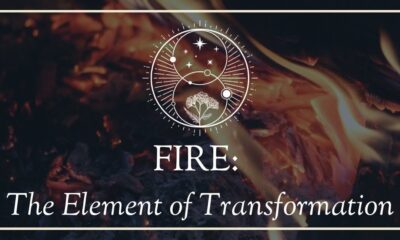Entertainment
The Symbolism of Fire in Greek and Japanese Creation Myths
Published
3 days agoon
By
Admin
Myths serve as the foundation of cultural narratives, often embodying the values, fears, and aspirations of a society. In many cultures, fire is a potent symbol, representing both destruction and creation, transformation and renewal. This duality is vividly illustrated in the creation myths of ancient Greece and Japan. By examining the role and symbolism of fire in these myths, we can gain deeper insights into how these cultures understood the world and their place within it.
Greek Creation Myths
In Greek mythology, fire is a central element in several key myths, often symbolizing divine power, knowledge, and the potential for both creation and destruction.
Prometheus and the Theft of Fire

One of the most famous Greek myths involving fire is the tale of Prometheus. Prometheus, a Titan, defies Zeus by stealing fire from the gods and giving it to humanity. This act of defiance is both a symbol of enlightenment and a catalyst for progress. Fire, in this context, represents knowledge, technology, and the spark of civilization. With fire, humans gain the ability to cook food, forge tools, and build civilizations.
However, Prometheus’ gift comes with a heavy price. Zeus punishes him by chaining him to a rock where an eagle eternally eats his liver, which regenerates each day. This punishment underscores the Greek perspective on the dual nature of fire: it is a source of power and advancement, but also a force that must be controlled and respected. The myth highlights the tension between human ambition and divine order, suggesting that the quest for knowledge and power can lead to severe consequences.
The Myth of Hephaestus
Hephaestus, the god of fire and metalworking, further illustrates the symbolic power of fire in Greek mythology. As the divine blacksmith, Hephaestus wields fire to forge weapons and artifacts for the gods, including Zeus’s thunderbolts and Achilles’ armor. His mastery of fire symbolizes the transformative and creative power of the element.
Hephaestus himself is a complex figure. Born lame and cast out of Olympus by his mother Hera, he represents both the potential for creation through adversity and the dangerous, uncontrollable aspects of fire. Despite his physical imperfections, his skill with fire and metalwork makes him indispensable to the gods, illustrating how fire’s creative potential can transcend and transform inherent flaws.
The Destruction of Phaethon
The story of Phaethon, the son of the sun god Helios, serves as a cautionary tale about the destructive power of fire. Phaethon convinces Helios to let him drive the sun chariot for a day, but he loses control, scorching the earth and creating deserts. Zeus intervenes by striking Phaethon with a thunderbolt, killing him to prevent further disaster.
This myth emphasizes the dangers of hubris and the need for balance. Fire, representing the sun’s energy, is essential for life but can become destructive if not properly harnessed. Phaethon’s tale underscores the importance of respecting natural forces and the catastrophic consequences of failing to do so.
Japanese Creation Myths
In Japanese mythology, fire also holds significant symbolic meaning, though it often emphasizes purification, transformation, and renewal.
The Birth of Fire God Kagutsuchi
The creation myth involving Kagutsuchi, the fire god, is pivotal in Shinto belief. According to the Kojiki, Kagutsuchi is born from the union of the deities Izanagi and Izanami, who are responsible for creating the Japanese islands. However, Kagutsuchi’s birth is so intense that it burns Izanami to death, leading to her descent into the underworld, Yomi.
Izanagi, in his grief and rage, decapitates Kagutsuchi, whose blood gives rise to several other deities, symbolizing the generative power of fire even in the midst of destruction. Kagutsuchi’s story highlights the dual nature of fire as both destructive and creative. The fire that kills Izanami also leads to the birth of new gods, symbolizing the cyclical nature of life, death, and rebirth.
The Purification of Izanagi
After his journey to the underworld to retrieve Izanami, Izanagi undergoes a purification ritual (misogi) to cleanse himself of the impurities he encountered in Yomi. During this ritual, fire is one of the elements used to purify and renew Izanagi, emphasizing fire’s role in cleansing and transformation.
This purification process is crucial in Shinto practice, where fire rituals (such as the burning of sacred objects) are performed to cleanse spaces and people of spiritual impurities. Fire, in this context, is a purifying force that restores balance and order, reflecting the cultural importance of ritual cleanliness and spiritual harmony in Japanese society.
Fire in Festivals and Rituals
Japanese culture also celebrates fire through various festivals and rituals. The Gozan no Okuribi (Daimonji) festival in Kyoto involves lighting large bonfires on mountains to guide ancestral spirits back to the spirit world. These fires serve as a connection between the physical and spiritual realms, illustrating fire’s role as a mediator and guide.
Similarly, the Fire Festival (Hi Matsuri) of Kurama involves participants carrying torches and lighting bonfires to purify the land and bring good fortune. These festivals highlight fire’s role in renewal and protection, reinforcing its positive aspects as a life-sustaining force.
Comparative Analysis
While Greek and Japanese creation myths both attribute significant symbolic meanings to fire, their cultural contexts shape these interpretations differently.
Creation and Destruction
In both mythologies, fire embodies the duality of creation and destruction. Greek myths often emphasize the danger and punishment associated with fire’s misuse, as seen in the stories of Prometheus and Phaethon. In contrast, Japanese myths focus more on fire’s transformative and purifying aspects, as illustrated by Kagutsuchi’s birth and Izanagi’s purification.
Divine Power and Human Ambition
Greek myths frequently portray fire as a divine power that, when accessed by humans, leads to severe consequences. Prometheus’ theft of fire represents human ambition and the desire for knowledge, while the subsequent punishment underscores the boundaries between mortals and gods. Japanese myths, however, present fire as a more integrated aspect of the natural and spiritual world, essential for purification and renewal.
Cultural Practices and Symbolism
The rituals and festivals in both cultures reflect their respective mythological views of fire. Greek fire symbolism is closely tied to the gods and the consequences of overstepping divine boundaries. Japanese fire symbolism, through its use in purification rituals and festivals, emphasizes harmony, balance, and the cyclical nature of life.
Conclusion
The symbolism of fire in Greek and Japanese creation myths reveals profound insights into each culture’s worldview. In Greek mythology, fire is a powerful and often dangerous force that can elevate humanity but also bring about its downfall. It symbolizes the tension between human aspiration and divine will. In Japanese mythology, fire is a transformative and purifying element, essential for maintaining spiritual and physical balance. It represents the interconnectedness of life and death, creation and destruction.
By exploring these myths, we not only understand the cultural significance of fire but also appreciate the universal themes of creation, transformation, and the quest for knowledge that transcend cultural boundaries. Fire, in its myriad symbolic forms, continues to be a potent force in human imagination and storytelling.

A Comprehensive Guide to Jesuits

VNC Distribution: Leading Wholesale Supplier of Disposable Vape Pods

Top Skills British Journalists Need to Succeed in 2024

Easy Vehicle Rental in Dubai: No Store Required

Exploring BaddieHub: Your Gateway to Diverse Content

BaddieHub: The Ultimate Digital Oasis for Building Confidence

Ark: Survival Evolved (2017) Game Icons Banners Guide

Streamlining Construction Projects with Mechanical Estimating and MEP Takeoff Services

The Symbolism of Fire in Greek and Japanese Creation Myths

Top 10 Benefits of Remote Business Startup Accounting and Bookkeeping Services

SEO Agency in Australia: Appkod

Drew Brees Makes His NBC Debut: Internet Amazed by His New Hair

Website Design: Unlocking the Potential with AppKod

What is Evırı? Everything You Need to Know

Lauren Boebert with her husband Jayson and four sons

Facebook Marketplace: Buy and Sell Items Locally or Shipped
Showcase Of Ark: Survival Evolved (2017) Icons And Banners

Maximizing Efficiency and Accuracy with Construction Takeoff and Estimating Services

Jayson Boebert Set to Appear in Court for Two Separate Cases

Unveiling the Mysteries and Benefits

A Comprehensive Guide to Jesuits

VNC Distribution: Leading Wholesale Supplier of Disposable Vape Pods

Top Skills British Journalists Need to Succeed in 2024

Easy Vehicle Rental in Dubai: No Store Required

Exploring BaddieHub: Your Gateway to Diverse Content

BaddieHub: The Ultimate Digital Oasis for Building Confidence

Ark: Survival Evolved (2017) Game Icons Banners Guide

Streamlining Construction Projects with Mechanical Estimating and MEP Takeoff Services

The Symbolism of Fire in Greek and Japanese Creation Myths













